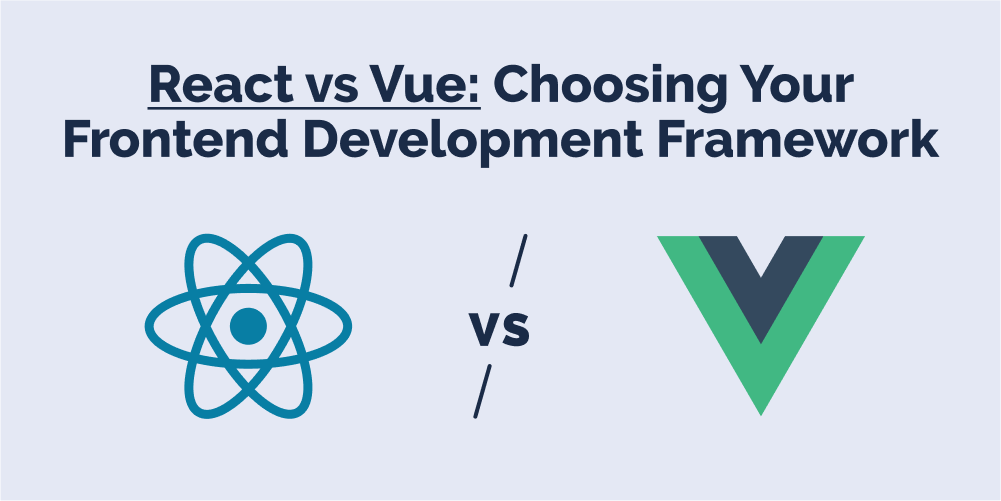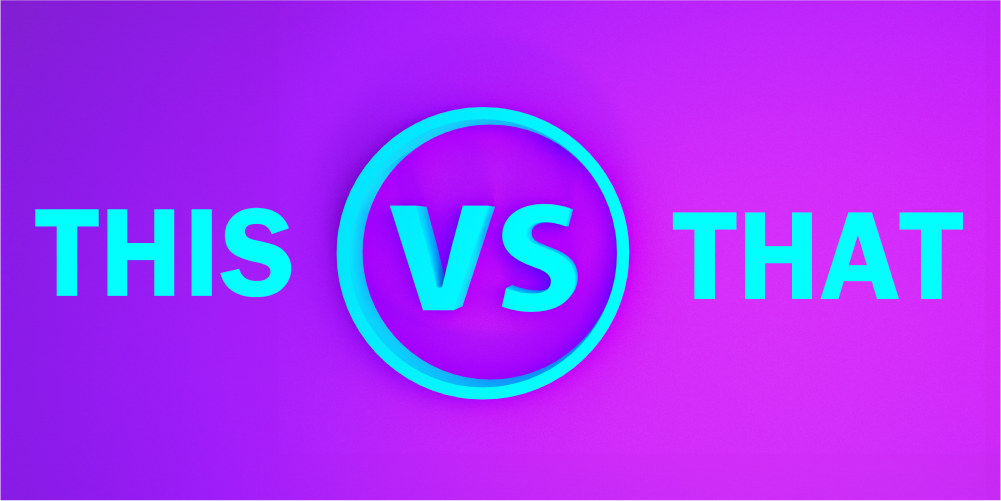Software Development, zBlog
React vs Vue – Which One to Choose for Your Frontend Development?

Introduction: React vs Vue – Which to Choose?
When it comes to modern web development, the choice of frontend framework plays a crucial role in shaping the overall user experience, performance, and maintainability of your application. Two of the most popular contenders in this arena are React vs Vue.js. While both frameworks have their own strengths and weaknesses, the decision to choose one over the other often depends on various factors, such as project requirements, team expertise, and long-term goals.
In this comprehensive blog post, we’ll delve into the key differences between React vs Vue, explore their respective features, and provide insights to help you make an informed decision for your next frontend development project.
React: A Powerful and Flexible Library

React, developed and maintained by Facebook (now Meta), is a JavaScript library for building user interfaces. It was initially released in 2013 and has since gained widespread popularity among developers due to its innovative approach to building reusable UI components.
Key Features of React:
- Component-Based Architecture: React promotes a modular and composable approach to UI development, where applications are built by combining small, reusable components. This makes code more maintainable, testable, and encourages reusability.
- Virtual DOM: React utilizes a virtual representation of the actual DOM (Document Object Model). When a component’s state changes, React calculates the minimal set of changes required and efficiently updates only the necessary parts of the DOM, resulting in improved performance and reduced overhead.
- JSX Syntax: React introduces JSX, a syntax extension that allows developers to write HTML-like code within JavaScript. This approach makes it easier to create and manage UI components, improving code readability and maintainability.
- Rich Ecosystem: React benefits from a vast and thriving ecosystem, with a plethora of third-party libraries and tooling available. Popular libraries like Redux for state management, React Router for routing, and React Native for mobile development further extend React’s capabilities.
- Learning Curve: While React has a relatively steep learning curve compared to some other frameworks, its conceptual model and component-based approach tend to resonate well with developers once they grasp the fundamentals.
Vue.js: The Progressive and Versatile Framework

Vue.js, created by Evan You, is a progressive JavaScript framework for building user interfaces. It was first released in 2014 and has since gained significant traction due to its simplicity, flexibility, and excellent performance.
Key Features of Vue.js:
- Progressive and Incrementally Adoptable: Vue.js is designed to be incrementally adoptable, allowing developers to integrate it into existing projects or build new applications from scratch. It can be used as a library for specific components or as a full-fledged framework for building complex applications.
- Virtual DOM: Similar to React, Vue.js utilizes a virtual DOM for efficient rendering and updating of UI components. This approach ensures optimal performance and minimizes unnecessary DOM manipulations.
- Reactive Data Binding: Vue.js employs a reactive data binding system, which automatically updates the UI when data changes, eliminating the need for manual DOM manipulation. This feature simplifies the development process and enhances code maintainability.
- Template Syntax: Vue.js uses an HTML-based template syntax that closely resembles the structure of the final rendered UI. This makes it easier for developers to understand and maintain the code, especially for those with experience in traditional web development.
- Lightweight and Performant: Vue.js is known for its lightweight footprint and excellent performance, making it well-suited for building high-performance applications, including single-page applications (SPAs) and mobile applications.
- Flexible and Modular: Vue.js embraces a modular approach, allowing developers to include or exclude specific features based on project requirements. This flexibility contributes to a smaller bundle size and improved performance.
- Growing Ecosystem: While not as extensive as React’s ecosystem, Vue.js has a rapidly growing community and a rich collection of libraries and tools, such as Vue Router for routing, Vuex for state management, and Vue Native for mobile development.
Comparing React vs Vue.js

To better understand which framework might be the right choice for your project, let’s compare React vs Vue.js across several key aspects:
- Learning Curve:
- React: React has a steeper learning curve, especially for developers new to the component-based architecture and JSX syntax. However, once the fundamental concepts are grasped, React becomes more intuitive.
- Vue.js: Vue.js is often praised for its easier learning curve, particularly for developers with experience in traditional web development. Its template syntax and reactive data binding make it more approachable for beginners.
- Performance:
- React: React’s virtual DOM and efficient diffing algorithm contribute to excellent performance, especially in large-scale applications with frequent updates.
- Vue.js: Vue.js also leverages a virtual DOM and provides impressive performance, often on par with or slightly better than React in certain scenarios.
- Flexibility and Extensibility:
- React: React is highly flexible and extensible, thanks to its rich ecosystem and the ability to create custom components and libraries. However, this flexibility can come at the cost of increased complexity and a steeper learning curve.
- Vue.js: Vue.js strikes a balance between flexibility and simplicity. While it offers a wide range of features and plugins, it aims to keep the core library lightweight and easy to understand.
- Community and Ecosystem:
- React: React has a massive and well-established community, with a vast ecosystem of third-party libraries, tools, and resources. This makes it easier to find solutions to common problems and leverage existing tools.
- Vue.js: While not as large as React’s community, Vue.js has a rapidly growing and dedicated community. Its ecosystem is expanding, with an increasing number of libraries and tools available.
- Tooling and Developer Experience:
- React: React benefits from a robust tooling ecosystem, including popular development tools like Create React App, Next.js, and Gatsby. These tools streamline the development process and provide features like server-side rendering and static site generation.
- Vue.js: Vue.js also offers excellent tooling and developer experience, with tools like Vue CLI and Nuxt.js for server-side rendering and static site generation. However, the ecosystem is not as mature as React’s.
- Corporate Backing and Adoption:
- React: React is backed by Meta (formerly Facebook), a tech giant with significant resources and a vested interest in the framework’s success. React has been widely adopted by many large companies and organizations.
- Vue.js: While Vue.js has gained significant popularity and adoption, it is primarily a community-driven project without major corporate backing. However, it has been embraced by companies like Gitlab, Xiaomi, and Alibaba.
- Rendering Approach:
- React: React follows a functional programming approach, where components are pure functions that receive props (input data) and return a rendered UI representation.
- Vue.js: Vue.js takes a more traditional object-oriented approach, with components being instances of Vue objects that have a lifecycle and manage their own state.
- State Management:
- React: React encourages a unidirectional data flow, where state is managed at the top level and passed down to child components as props. For complex state management, libraries like Redux or MobX are commonly used.
- Vue.js: Vue.js provides a built-in reactivity system for state management within components. For larger applications, the Vuex library is recommended for centralized state management.
- Native Mobile Development:
- React: React Native, a separate library from React, allows developers to build native mobile apps using the same fundamental concepts and APIs as React for the web.
- Vue.js: Vue Native is a community-driven project that enables developers to build native mobile apps using Vue.js components and APIs.
- Documentation and Learning Resources:
- React: React has extensive official documentation and a wealth of third-party learning resources, including online courses, tutorials, and books.
- Vue.js: Vue.js also provides comprehensive official documentation and a growing number of learning resources, such as tutorials, videos, and books.
Choosing the Right Framework

Ultimately, the decision between React vs Vue.js will depend on various factors specific to your project, team, and organizational requirements. Here are some general guidelines to consider:
- Project Scope and Complexity: For large-scale, complex applications with frequent updates and a need for robust state management, React may be a better choice due to its maturity, extensive ecosystem, and proven performance at scale.
- Team Experience and Expertise: If your team has prior experience with React or has a strong JavaScript background, sticking with React may be the more practical choice to leverage existing knowledge and minimize the learning curve
- Learning Curve: If you’re working with a team of developers who are new to modern frontend frameworks or have a background in more traditional web development, Vue.js might be a better choice due to its relatively easier learning curve and approachable syntax.
- Performance Requirements: Both React and Vue.js offer excellent performance, but if you’re building a highly interactive application with frequent updates, React’s virtual DOM and efficient diffing algorithm may give it a slight edge.
- Tooling and Developer Experience: If you value a robust tooling ecosystem and a streamlined development experience, React’s mature ecosystem and tools like Create React App, Next.js, and Gatsby might be more appealing.
- Corporate Backing and Adoption: If having a framework backed by a major tech company is important to your organization, React’s association with Meta (formerly Facebook) might be a deciding factor.
- Project Requirements and Constraints: Consider factors like project deadlines, budget constraints, and the specific requirements of your application. Vue.js might be a better choice for smaller projects or prototypes due to its simplicity and faster development cycle.
- Third-Party Ecosystem: If your project requires extensive integration with third-party libraries and tools, React’s larger ecosystem might be more suitable, as it offers a wider range of battle-tested solutions.
- Mobile Development: If you plan to develop native mobile applications alongside your web application, React Native and Vue Native can both be suitable choices, depending on your team’s expertise and preferences.
- Long-term Roadmap and Maintenance: While both React and Vue.js have active development and strong communities, it’s worth considering the long-term roadmap and the potential for future updates and support based on your project’s lifespan.
It’s important to note that both React and Vue.js are capable frameworks, and the decision may ultimately come down to personal preferences, team expertise, and project-specific requirements. In some cases, it might even be possible to adopt a hybrid approach, using React and Vue.js components together within the same application.
Transforming Product Development with Trantor
While the choice between React vs Vue.js is crucial for frontend development, the true success of a product often hinges on the ability to innovate and adapt to evolving market demands. This is where Trantor, a cutting-edge software development company, shines.
Trantor is dedicated to fueling business expansion through innovation, leveraging its expertise in emerging technologies and agile methodologies. By partnering with Trantor, organizations can unlock new avenues for growth, streamline their product development processes, and stay ahead of the competition.
Trantor’s proficient developers and designers effortlessly merge with clients’ current teams, offering a new outlook and valuable expertise. Through Trantor’s CaptiveCoE™ engagement approach, clients gain access to co-branded, extended teams that adjust to their needs swiftly, enabling rapid product development and delivery. Our deep understanding of both React and Vue.js frameworks, combined with our proficiency in other modern technologies, allows us to deliver high-performance, feature-rich applications tailored to specific business needs.
Whether you’re building a new product from scratch or enhancing an existing one, Trantor’s agile approach ensures a collaborative and iterative development process. By fostering open communication and incorporating client feedback at every stage, Trantor ensures that the final product aligns perfectly with your vision and meets the evolving demands of your target audience.
Conclusion
In the ever-evolving landscape of frontend development, the choice between React vs Vue.js is a consequential one. Both frameworks offer compelling features, robust ecosystems, and dedicated communities, making the decision a matter of carefully weighing project requirements, team expertise, and long-term goals.
While React’s maturity, extensive ecosystem, and proven performance at scale make it a solid choice for complex applications, Vue.js’s simplicity, approachable learning curve, and excellent performance make it an attractive option, particularly for smaller projects or teams new to modern frontend frameworks.
Ultimately, the decision should be driven by a thorough evaluation of your specific needs, constraints, and priorities. Whether you choose React or Vue.js, partnering with a reliable and innovative product development company like Trantor can amplify your chances of success.
Trantor’s expertise in cutting-edge technologies, coupled with their agile approach and commitment to innovation, positions them as an ideal partner for organizations seeking to transform their product development processes and fuel business expansion. By leveraging Trantor’s skills and insights, you can navigate the complexities of frontend development with confidence, ensuring that your applications not only meet but exceed the evolving demands of your users.




